STIHL SR 450, SR 430 Owner's Manual
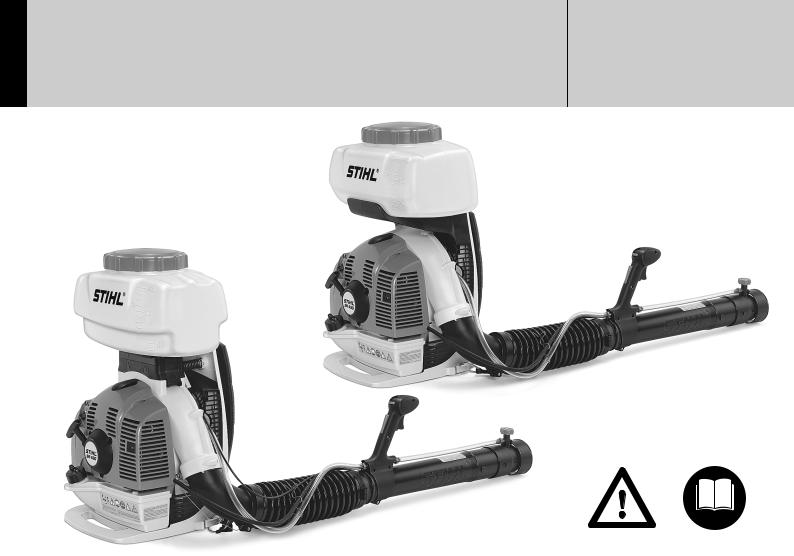
{
STIHL SR 430, 450
Instruction Manual Manual de instrucciones
Warning!
Read and follow all safety precautions in Instruction Manual – improper use can cause serious or fatal injury.
Advertencia!
Lea y siga todas las precauciones de seguridad dadas en el manual de instrucciones – el uso incorrecto puede causar lesiones graves o mortales.
Instruction Manual 1 - 46
Manual de instrucciones 47 - 96

Contents
|
|
Guide to Using this Manual |
2 |
|
|
|
Safety Precautions and Working |
|
|
|
|
Techniques |
2 |
|
Manual |
|
Assembling the Unit |
12 |
|
|
Adjusting the Throttle Cable |
14 |
||
Instruction |
|
Fuel |
15 |
|
|
|
Harness |
15 |
|
Original |
|
Fueling |
16 |
|
|
Information Before You Start |
17 |
||
|
recycled. |
Starting / Stopping the Engine |
18 |
|
|
Metering Unit |
20 |
||
|
|
Operating Instructions |
20 |
|
|
be |
Dusting and Spreading Mode |
23 |
|
|
can |
|||
|
Calculating Required Quantity of |
|
||
|
paper |
|
||
|
Solution |
25 |
||
paperfree-chlorineon |
oils, |
Filling the Container |
26 |
|
vegetablecontaininks |
Working |
27 |
||
|
|
|||
|
|
After Finishing Work |
28 |
|
|
|
Storing the Machine |
29 |
|
|
|
Engine Management |
29 |
|
Printed |
Printing |
Replacing the Air Filter |
30 |
|
Adjusting the Carburetor |
30 |
|||
|
|
|||
|
|
Spark Plug |
31 |
|
|
|
Engine Running Behavior |
32 |
|
|
|
Replacing the Starter Rope and |
|
|
2010 |
|
Rewind Spring |
33 |
|
|
Inspections and Maintenance by |
|
||
STIHLANDREAS© AG & Co. KG, |
8621-454-0458-B. M1.A10.MET. 0020000002257GB |
Dealer |
35 |
|
{ |
36 |
|||
|
|
Maintenance and Care |
||
|
|
Main Parts |
38 |
|
|
|
Specifications |
40 |
|
|
|
Special Accessories |
41 |
Maintenance and Repairs
STIHL Incorporated Federal
Emission Control Warranty
Statement
STIHL Incorporated California
Exhaust and Evaporative
Emissions Control Warranty
Statement
Trademarks
English
41Allow only persons who fully understand this manual to operate your mistblower.
|
To receive maximum performance and |
41 |
satisfaction from your STIHL |
|
mistblower, it is important that you read |
|
and understand and follow the |
|
maintenance and safety precautions in |
43 |
chapter "Safety Precautions and |
45 |
Working Techniques" before using your |
|
mistblower. For further information you |
||
|
||
|
can go to www.stihlusa.com. |
|
|
Contact your STIHL dealer or the STIHL |
|
|
distributor for your area if you do not |
|
|
understand any of the instructions in this |
|
|
manual. |
|
|
Warning! |
|
|
Because a mistblower is a power tool for |
|
|
spraying chemicals, some special safety |
|
|
precautions must be observed as with |
|
|
any other power tool to reduce the risk of |
|
|
personal injury. Careless or improper |
|
|
use may cause serious or even fatal |
|
|
injury. |
SR 430, SR 450 |
1 |

English
Guide to Using this Manual
Pictograms
All the pictograms attached to the machine are shown and explained in this manual.
Symbols in Text
Many operating and safety instructions are supported by illustrations.
The individual steps or procedures described in the manual may be marked in different ways:
NA bullet marks a step or procedure without direct reference to an illustration.
A description of a step or procedure that refers directly to an illustration may contain item numbers that appear in the illustration. Example:
N Loosen the screw (1). N Lever (2) ...
In addition to the operating instructions, this manual may contain paragraphs that require your special attention. Such paragraphs are marked with the symbols and signal words described below:
 Danger!
Danger!
Indicates an imminent risk of severe or fatal injury.
 Warning!
Warning!
Indicates a hazardous situation which, if not avoided, could result in severe or fatal injury.
Caution!
Indicates a risk of property damage, including damage to the machine or its individual components.
Engineering Improvements
STIHL’s philosophy is to continually improve all of its products. As a result, engineering changes and improvements are made from time to time. Therefore, some changes, modifications and improvements may not be covered in this manual. If the operating characteristics or the appearance of your machine differ from those described in this manual, please contact your STIHL dealer for assistance.
Safety Precautions and
Working Techniques
Because the mistblower is a power tool for spraying chemicals, special safety precautions must be observed to reduce the risk of personal injury.
It is important that you read, fully understand and observe the following general safety precautions and warnings. Read the instruction manual and the safety precautions periodically. In addition, read and follow the chemical manufacturer’s instructions for the chemical products being applied. Since such products may vary greatly in handling/application requirements and risks, the product label is normally your best guide for safe and effective use.
Use your power tool for spraying chemicals and other liquids to control pests and weeds in fruit, flower and vegetable gardens, on trees and bushes and on other plants, such as coffee, tobacco and cotton. It is also useful in the maintenance of young trees for, e.g., controlling the bark beetle and other pests and plant diseases.
Only use plant protection products that are specifically approved for use in sprayers/mistblowers by their
2 |
SR 430, SR 450 |

manufacturer and that meet all applicable safety regulations, standards and ordinances.
 Warning!
Warning!
Do not use it for other purposes, since misuse may result in personal injury or property damage, including damage to the machine.
Have your STIHL dealer show you how to operate your power tool. Observe all applicable local safety regulations, standards and ordinances.
All operating and servicing personnel should be trained and familiarized with the proper handling procedures for the chemical products being used, as well as with first aid/emergency care, and liquid and dry chemical disposal regulations.
Warning!
Your power tool is for professional use only. Do not lend or rent your power tool without the instruction manual. Be sure that anyone using it understands the information contained in this instruction manual.
Warning!
Minors should never be allowed to use this power tool. Bystanders, especially children, and animals should not be allowed in the area where it is in use.
 Warning!
Warning!
To reduce the risk of injury to bystanders and damage to property, never let your power tool run unattended. When it is not in use (e.g. during a work break), shut it off and make sure that unauthorized persons do not use it.
Most of these safety precautions and warnings apply to the use of all STIHL mistblowers. Different models may have different parts and controls. See the appropriate section in this instruction manual for a description of the controls and the function of the parts of your model.
Safe use of a mistblower involves
1.the operator
2.the power tool
3.the handling of the chemicals to be sprayed.
4.the use of the power tool
THE OPERATOR
Physical Condition
You must be in good physical condition and mental health and not under the influence of any substance (drugs, alcohol, etc.) which might impair vision, dexterity or judgment. Do not operate this machine when you are fatigued.
English
 Warning!
Warning!
Be alert – if you get tired, take a break. Tiredness may result in loss of control. Working with any power tool can be strenuous. If you have any condition that might be aggravated by strenuous work, check with your doctor before operating this machine.
Warning!
Prolonged use of a power tool (or other machines) exposing the operator to vibrations may produce whitefinger disease (Raynaud's phenomenon) or carpal tunnel syndrome.
These conditions reduce the hand's ability to feel and regulate temperature, produce numbness and burning sensations and may cause nerve and circulation damage and tissue necrosis.
All factors which contribute to whitefinger disease are not known, but cold weather, smoking and diseases or physical conditions that affect blood vessels and blood transport, as well as high vibration levels and long periods of exposure to vibration are mentioned as factors in the development of whitefinger disease. In order to reduce the risk of whitefinger disease and carpal tunnel syndrome, please note the following:
Most STIHL power tools are available with an anti-vibration ("AV") system designed to reduce the transmission of vibrations created by the machine to the operator's hands. An AV system is recommended for those persons using power tools on a regular or sustained basis.
SR 430, SR 450 |
3 |
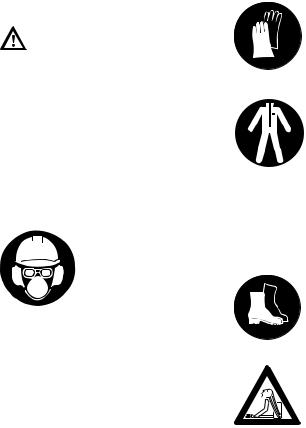
English
–Wear gloves and keep your hands warm.
–Keep the AV system well maintained. A power tool with loose components or with damaged or worn AV elements will tend to have higher vibration levels.
–Maintain a firm grip at all times, but do not squeeze the handles with constant, excessive pressure. Take frequent breaks.
All the above-mentioned precautions do not guarantee that you will not sustain whitefinger disease or carpal tunnel syndrome. Therefore, continual and regular users should closely monitor the condition of their hands and fingers. If any of the above symptoms appear, seek medical advice immediately.
 Warning!
Warning!
The ignition system of the STIHL unit produces an electromagnetic field of a very low intensity. This field may interfere with some pacemakers. To reduce the risk of serious or fatal injury, persons with a pacemaker should consult their physician and the pacemaker manufacturer before operating this tool.
Proper Clothing
Warning!
To reduce the risk of injury when working with chemical agents, the operator should wear proper protective apparel when filling, using and cleaning the power tool. Always follow all of the chemical manufacturer’s instructions with respect to proper eye, skin and respiratory protection. They may differ from and exceed the following precautions.
 Warning!
Warning!
To reduce the risk of injury to your eyes never operate your
power tool unless wearing goggles or properly fitted protective glasses
with adequate top and side protection complying with ANSI Z 87.1.
Power tool noise may damage your hearing. Wear sound barriers (ear plugs or ear mufflers) to protect your hearing. Continual and regular users should have their hearing checked regularly.
Be particularly alert and cautious when wearing hearing protection because your ability to hear warnings (shouts, alarms, etc.) is restricted.
When working with toxic chemicals, the operator and any bystanders may need to wear a properly fitted respirator approved by NIOSH/MSHA for the chemical being used. Consult the product label. Breathing toxic chemicals can cause serious or fatal injury.
Always wear rub- ber/chemical-resistent gloves when handling this power tool.
For some chemicals it is advisable to wear impermeable coveralls or an impermeable work apron. Check the product label. If you are spraying overhead or if the spray may reach head height, wear a wide brim hat or other suitable head covering. Do not wear shorts, sandals or go barefoot.
Wear rubber/chemicalresistent boots.
Avoid loose-fitting jackets, scarfs, neckties, jewelry, flared or cuffed pants, unconfined long hair or anything that could become caught on branches, brush or the moving parts of the unit. Secure hair so it is above shoulder level.
4 |
SR 430, SR 450 |
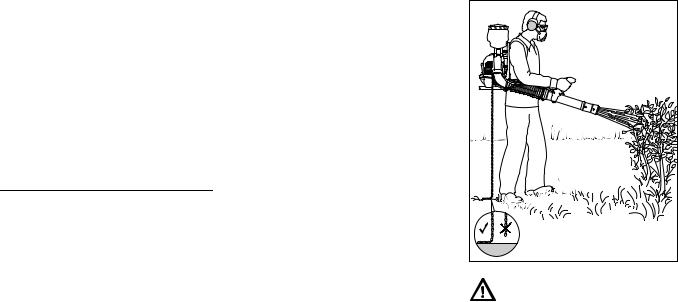
 Warning!
Warning!
In limited circumstances, mistblowers may also be used in greenhouses that are very well-ventilated if the operator can protect himself or herself from any harmful effects through the use of proper eye, skin and respiratory protection. Such work may require special precautions, and must not be prohibited on the chemical product label.
THE POWER TOOL
For illustrations and definitions of the power tool parts see the chapter on "Main Parts and Controls."
 Warning!
Warning!
Never modify this power tool in any way. Only attachments supplied by STIHL or expressly approved by STIHL for use with the specific STIHL model are authorized. Although certain unauthorized attachments are useable with STIHL power tools, their use may, in fact, be extremely dangerous.
If this tool is subjected to unusually high loads for which it was not designed (e.g. heavy impact or a fall), always check that it is in good condition before continuing work. Check in particular that the fuel system is tight (no leaks) and that the controls and safety devices are working properly. Do not continue operating this machine if it is damaged. In case of doubt, have it checked by your STIHL servicing dealer.
Dusting and spreading mode – SR 450 only
The dusting and spreading mode can be used for powder or dry granulate up to a grain size of 5 mm.
Observe all legal requirements for handling the chemicals. Observe the directions for use on the label of the product at issue.
Using the dusting and spreading mode
 Warning!
Warning!
An electrostatic charge may be created in the extension tube and nozzle area when applying dry materials (e.g. dusts) with the dusting and spreading attachment. This is especially true in low humidity conditions. Check the label and/or material safety data sheet for the chemical you are applying. To reduce the risk of severe or fatal injury, do not use your mistblower to apply substances that may create a combustible or explosive dust cloud. For instance, never use your mistblower to apply sulfur or sulfur compounds, since they may be highly explosive and have relatively low melting and ignition points.
English |
0002BA001 KN |
Warning! |
To reduce the risk of sparking when applying any dry substance, make sure that the discharge system (antistatic wire in the mistblower connected to a metal chain) is completely and properly mounted to the machine, and that the discharge chain is making contact with the ground. It is essential to follow the assembly instructions – see the chapter "Assembling the Unit" in this instruction manual.
Do not use the dusting and spreading attachment on non-conductive surfaces (e.g. plastic, asphalt).
Never operate your machine with a missing or damaged discharge system.
SR 430, SR 450 |
5 |
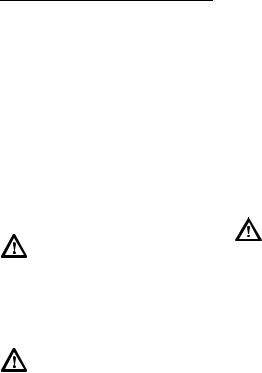
English
HANDLING OF CHEMICALS
 Warning!
Warning!
Some chemicals sprayed with your power tool may contain toxic and/or caustic substances. Such chemicals can be dangerous and cause serious or fatal injury to persons and animals and/or severe damage to plants and the environment.
Avoid direct contact with chemicals. Follow the chemical manufacturer’s instructions with respect to any contact with its product.
Warning!
Read the label each time before mixing or using the chemical and before storing or disposing of it. Do not trust your memory. Careless or improper use may cause serious or fatal injury.
Warning!
Chemicals can be harmful to individuals, animals and the environment if improperly used. In addition, some chemicals that are caustic, corrosive or poisonous should not be used in your mistblowers.
Carefully read the labels on chemical containers prior to use. Chemicals are classified into categories of toxicity.
Pesticides regulated by the EPA, for instance, use signal words to indicate the product’s potential to make you sick. "Caution" appears on pesticides found to be least harmful to humans. "Warning" indicates a product that is more poisonous than those in the
6
"Caution" group. Pesticides with the signal word "Danger" on the label are very poisonous or irritating. They should be used with extreme care. Finally, pesticides labeled "Danger – Poison" are for restricted use only and generally must be used under the supervision of a certified applicator. Each category will have unique handling characteristics. Familiarize yourself with the characteristics for the category you are using.
Chemicals may be used only by persons trained in their handling and the appropriate first-aid measures.
Warning!
Mix only compatible pesticides. Wrong mixtures can produce toxic fumes.
When handling chemicals and when spraying, make sure you are operating in accordance with local, state, and federal environmental protection rules and guidelines. Do not spray in windy conditions. To help protect the environment, use only the recommended dosage – do not overuse. Pay special attention when using near watersheds, waterway, etc.
 Warning!
Warning!
Do not eat, drink, or smoke while handling chemicals or while you are spraying. Never blow through nozzles, valves, pipes or any other component by mouth. Always handle chemicals in a well-ventilated area while wearing appropriate protective clothing and safety equipment. Do not store or transport chemicals together with food or medicines, and never reuse a chemical container for any other purpose.
Do not transfer dry or liquid chemicals to other containers, especially food and/or drink containers.
 Warning!
Warning!
In case of accidental contact or ingestion of chemicals or in case of contamination of clothing, stop work and immediately consult the chemical manufacturer’s instructions. If in doubt as to what to do, consult a poison control center or doctor without delay. Have the product’s label available to read to or show the persons you consult.
Clean all chemical spills immediately. Dispose of any residue in accordance with state or federal laws and regulations.
 Warning!
Warning!
Keep chemicals out of reach of children, other unauthorized people and animals. When not in use, store chemicals in a safe place. Follow the manufacturer’s recommendations for proper storage.
SR 430, SR 450
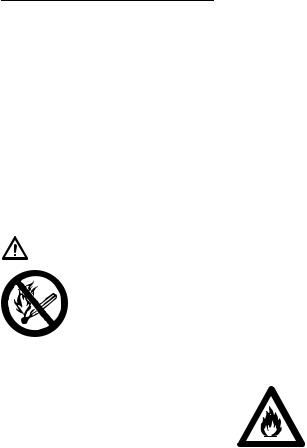
Preparing chemicals
Prepare chemical solutions of according to manufacturer's instructions.
–Only prepare sufficient solution for the job at hand so that nothing is left over.
–Mix chemicals only in accordance with instructions – wrong mixtures can produce toxic fumes or explosive mixtures.
–Never spray chemicals undiluted.
–Prepare solution and fill the container outdoors only, in wellventilated locations.
Storage
–Do not store spray solution in the container for longer than one day.
–Store and transport spray solution only in approved containers.
–Never store the spray solution in containers intended for foods, drinks or animal feed.
–Do not store spray solution with foods, drinks or animal feed.
–Keep spray solution out of the reach of children and animals.
–Store the spray solution in a place secured against unauthorized use.
Disposal
Never dispose of residual chemicals or contaminated rinsing solutions in waterways, drains, sewers, street gutters or manholes.
SR 430, SR 450
Disposal of contaminated rinse should be in accordance with all applicable laws, regulations and ordinances. Observe the precautionary instructions of the chemical manufacturer.
THE USE OF THE POWER TOOL
Transporting the Power Tool
Always switch off the engine before taking the machine off your back and putting it down. Empty container when transporting it in a vehicle; properly secure it to prevent turnover, fuel spillage and damage to the unit.
Fuel
Your STIHL power tool uses an oilgasoline mixture for fuel (see the chapter on "Fuel" in this instruction manual).
Warning!
Gasoline is an extremely flammable fuel. If spilled and ignited by a spark or
other ignition source, it can cause fire and serious burn injury or
property damage. Use extreme caution when handling gasoline or fuel mix. Do not smoke or bring any fire or flame near the fuel or the power tool. Note that combustible fuel vapor may escape from the fuel system.
English
Fueling Instructions
 Warning!
Warning!
To reduce the risk of serious injury from burns, never attempt to refuel the unit until it has been completely removed from the operator.
 Warning!
Warning!
Fuel your power tool in well-ventilated areas, outdoors. Always shut off the engine and allow it to cool before refueling. Gasoline vapor pressure may build up inside the fuel tank depending on the fuel used, the weather conditions and the tank venting system.
In order to reduce the risk of burns and other personal injury from escaping gas vapor and fumes, remove the fuel filler cap on your power tool carefully so as to allow any pressure build-up in the tank to release slowly. Never remove the fuel filler cap while the engine is running.
Select bare ground for fueling and move at least 10 feet (3 m) from the fueling spot before starting the engine. Wipe off any spilled fuel before starting your machine.
 Warning!
Warning!
Check for fuel leakage while refueling and dur-
ing operation. If fuel leakage is found, do not start or run the engine until the leak is fixed and
any spilled fuel has been wiped away. Take care not to get fuel on your clothing. If this happens, change your clothing immediately.
7

English
Bayonet Fuel Filler Cap
Never use a tool to open or close the bayonet fuel filler cap, as this could damage the cap and cause fuel to leak out.
The bayonet fuel filler cap must be closed with care after refuelling.
Filling the Container
 Warning!
Warning!
Tighten all connections and check to be sure the hose is securely attached and in good condition. Keep the valve lever on the control lever closed.
Before using the power tool with chemicals, fill it with fresh water to assure that you have it properly assembled and practice spraying. Also, check for any leaks at this time. When thoroughly familiar with the power tool operation, follow normal operating procedures.
Fill your power tool in well-ventilated areas, outdoors.
 Warning!
Warning!
Do not use:
–flammables in the mistblower, which can explode causing serious or fatal injury;
–caustic or corrosive materials in the mistblower, that could result in damage to the unit;
–liquids with a temperature above 120° F (50° C) to avoid scalding and damage to the unit.
To fill the container, place the power tool on a level surface. To reduce the risk of contaminating the surrounding environment, be careful not to overfill the container with chemical solution.
To reduce the risk of injury, do not fill the unit while wearing it on your back.
If you fill the container with a hose attached to a central water supply, be sure the end of the hose is out of the solution to reduce the risk of backflow, i.e. the chemicals being sucked into the water supply in the case of a sudden vacuum.
Calculate the correct amount of chemical solution so that it is used up at one time, with no extra solution left in the tank.
After filling, fit the container cap and tighten it down firmly.
 Warning!
Warning!
Check for leakage while refilling and during operation. A leak from the container or a loose fitting could soak your clothing and come into contact with your skin.
Before Starting
 Warning!
Warning!
Always check your power tool for proper condition and operation before starting, particularly the throttle trigger and setting lever with stop position. The throttle trigger must move freely and always spring back to the idle position. Never attempt to modify the controls or safety devices.
 Warning!
Warning!
To reduce the risk of leakage and skin contact with chemicals, check that the container cap and all connections in the path of the spray are tight, and be sure the hose is securely attached and in good condition. Keep the valve lever closed.
 Warning!
Warning!
Never operate your power tool if it is damaged, improperly adjusted or maintained, or not completely or securely assembled.
 Warning!
Warning!
Check that the spark plug boot is securely mounted on the spark plug – a loose boot may cause arcing that could ignite combustible fumes and cause a fire.
Keep the control handle clean and dry at all times; it is particularly important to keep it free of moisture, pitch, oil, fuel mix, grease or resin in order for you to maintain a firm grip and properly control your power tool.
8 |
SR 430, SR 450 |
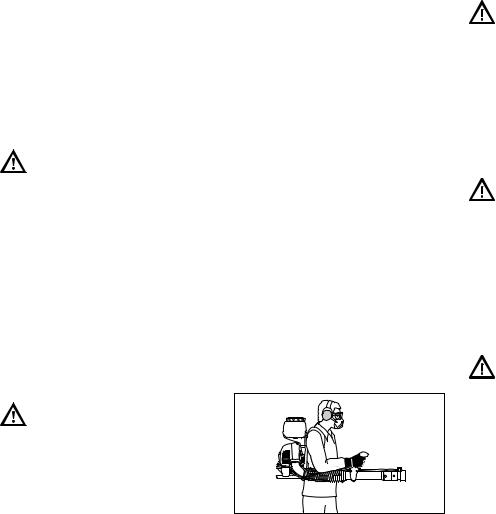
 Warning!
Warning!
To reduce the risk of injury from thrown parts, check the fan housing for damage (cracks, nicks, chipping). If any damage is found, stop using the unit and contact your STIHL dealer for repair.
Check condition of harness straps and replace damaged or worn straps.
Warning!
Adjust carrying harness to suit your size before starting work.
In an emergency, you may slip out of the harness and throw off the machine quickly. Try slipping out of the harness a number of times before using the machine in order to become accustomed to it. Do not throw off the machine while practicing as it could damage the machine.
Starting
Start the engine at least 10 feet (3 m) from the fueling spot, outdoors only.
Warning!
Your power tool is a one-person machine. To reduce the risk of eye or other injury from thrown objects, insure that bystanders are at least 50 feet (15 m) away when starting and during use. Stop operation immediately if you are approached.
For specific starting instructions, see the appropriate section in this instruction manual. Place the power tool on firm ground or other solid surface in an open area. Maintain good balance and secure footing.
SR 430, SR 450
 Warning!
Warning!
When you pull the starter grip, do not wrap the starter rope around your hand. Do not let the grip snap back, but guide the starter rope to rewind it properly. Failure to follow this procedure may result in injury to your hand or fingers and may damage the starter mechanism.
The assistance of another person may be needed in placing the unit on your back after starting. In order to reduce the risk of injury to the assistant from thrown objects, chemical spray/dust or from contact with hot exhaust fumes, the engine should be kept at idle speed during this brief period, and your assistant should not stand in the area of the outlet nozzle or exhaust. Otherwise, the unit should be started and operated without assistance.
During Operation
Holding and Controlling the Power
Tool
0002BA002 KN
The mistblower is designed for singlehanded operation with the right hand on the control handle. It should be carried as a backpack with the straps of the harness over both shoulders.
English
Warning!
To reduce the risk of loss of control, never carry the unit with the strap(s) over one shoulder.
Wrap your fingers tightly around the handle, keeping the control handle cradled between your thumb and forefinger. Keep your hand in this position to have your machine under control at all times.
Warning!
In order to keep the container upright and reduce the risk of spillage, do not bend at the waist. Bend only at the knees and support yourself as required to ensure proper balance.
Remember that a mistblower filled with liquid has a significant amount of weight. Use caution when bending, leaning or walking.
Warning!
Do not overreach. Keep proper footing and balance at all times. Special care must be taken in slippery conditions (wet ground, snow and ice) and in difficult, overgrown terrain. Watch for hidden obstacles such as tree stumps, roots and ditches to avoid stumbling. For better footing, clear away fallen branches, scrub and cuttings. Be extremely cautious when working on slopes or uneven ground.
To reduce the risk of stumbling and loss of control, do not walk backward while operating the machine. Avoid stepping on antistatic chain – SR 450 only.
9
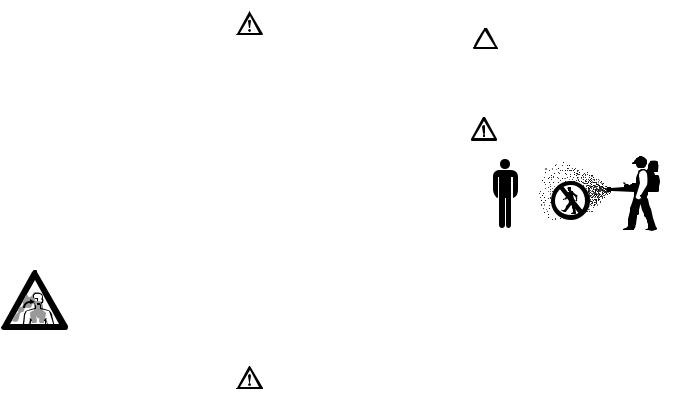
English
 Warning!
Warning!
To reduce the risk of injury from loss of control, never work on a ladder, in a tree or on any other insecure support.
During work breaks, do not leave the power tool in the hot sun or near any heat source.
Working Conditions
Operate and start your power tool only outdoors in a well-ventilated area. Operate it under good visibility and daylight conditions only. Work carefully.
 Warning!
Warning!
As soon as the engine is running, this product gen-
erates toxic exhaust fumes containing chemicals, such as unburned hydrocarbons (including
benzene) and carbon monoxide, that are known to cause respiratory illness / injury, cancer, birth defects, or other reproductive harm. Some of the gases (e.g. carbon monoxide) may be colorless and odorless. To reduce the risk of serious or fatal injury/illness from inhaling toxic fumes, never run the machine indoors or in poorly ventilated locations.
Warning!
Inhalation of chemicals can cause susceptible persons to have an allergic or asthmatic reaction. Substantial or repeated inhalation of certain chemicals may cause respiratory disease, cancer, birth defects or other reproductive harm. Control the chemical spray/dust at the source where possible. Use good work practices, such as operating the unit so that the wind or operating process does not blow the chemical spray/dust back on the operator. Follow the recommendations of EPA/OSHA/NIOSH and occupational and trade associations with respect to proper usage. When the inhalation of the chemical spray/dust being applied cannot be avoided, the operator and any bystanders may need to wear a respirator approved by NIOSH/MSHA for the type of chemical encountered. Consult the label of the chemical product being used.
Warning!
If you are unfamiliar with the risks associated with the particular chemical at issue, review the product label and/or material safety data sheet for that substance and/or consult the material manufacturer/supplier. You may also consult your employer, governmental agencies such as the EPA, OSHA and NIOSH and other sources on hazardous materials. The state of California and some other authorities, for instance, have published lists of substances known to cause cancer, reproductive toxicity, etc.
Operating instructions
 Warning!
Warning!
In the event of an emergency, switch off the engine immediately – move the setting lever to 0 or STOP.
Warning!
Never spray in the direction of humans, animals or property which might be injured or damaged by spray formula.
Pay attention to the direction of the wind, i.e., do not work against the wind. When spraying, stand so that the wind does not blow towards you or bystanders.
Keep children and pets away from areas that have just been sprayed. After the use of some chemicals, especially agricultural pesticides, a notice must be posted on the treated area that a "Restricted Entry Interval" (REI) is in effect. See the product’s label and any applicable governmental regulations.
10 |
SR 430, SR 450 |
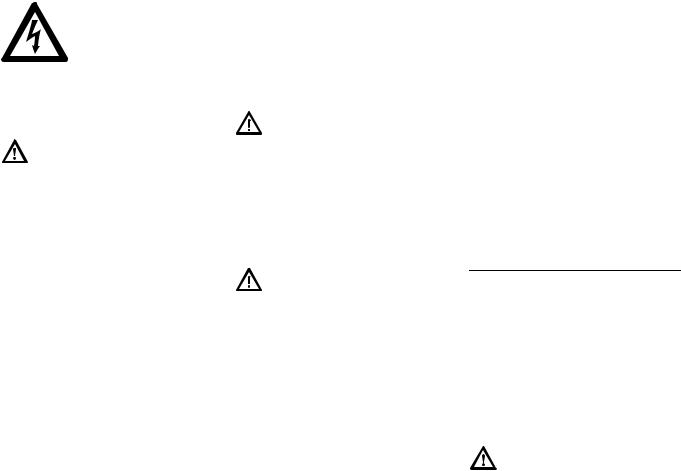
 Danger!
Danger!
Your power tool is not insulated against electric shock. To reduce the risk of electrocution, never operate this power tool in the vicinity of any wires or
cables (power, etc.) which may be carrying electric current. Do not spray on or near electrical installations.
Warning!
To reduce the risk of personal injury, do not direct air blast towards bystanders, since the high pressure of the air flow could injure eyes and could blow small objects at great speed.
 Warning!
Warning!
The blower fan between the air intake and output openings rotates whenever the engine is running.
Never insert any foreign object into the air intake of the machine or into the nozzle of the blower. It will damage the fan wheel and may cause serious injury to the operator or bystanders as a result of the object or broken parts being thrown out at high speed.
Do not place the blower on the ground when operating at high speed, because small objects such as sand, grass, dust, etc. may be pulled into the air intake and damage the fan wheel.
 Warning!
Warning!
The muffler and other parts of the engine (e.g. fins of the cylinder, spark plug) become hot during operation and remain hot for a while after stopping the engine. To reduce risk of burns do not touch the muffler and other parts while they are hot.
Warning!
To reduce the risk of fire and burn injury, keep the area around the muffler clean. Remove excess lubricant and all debris such as pine needles, branches or leaves. Let the engine cool down sitting on concrete, metal, bare ground or solid wood (e.g. the trunk of a felled tree) away from any combustible substances.
Warning!
Never modify your muffler. The muffler could be damaged and cause an increase in heat radiation or sparks, thereby increasing the risk of fire and burn injury. You may also permanently damage the engine. Have your muffler serviced and repaired by your STIHL servicing dealer only.
After Finishing Work
Always wash yourself thoroughly with soap and water after spraying or handling chemicals. Shower immediately, and wash all protective clothing separately from other items. Follow any additional recommendations of the chemical manufacturer.
Always clean dust and dirt off the power tool.
English
 Warning!
Warning!
Empty, rinse and clean container and assembly after each use. This helps to prevent the solution from crystallizing, which could later cause clogging and chemical damage to the unit. In addition, residual chemicals may have undesirable effects during subsequent spraying with a different type of chemical (e.g., residual herbicide may damage or kill plants being sprayed with a pesticide).
Do not store the mistblower with spray solution in the container.
Store the unit in a place secured against unauthorized use.
MAINTENANCE, REPAIR AND STORING
Maintenance, replacement, or repair of the emission control devices and systems may be performed by any nonroad engine repair establishment or individual. However, if you make a warranty claim for a component which has not been serviced or maintained properly or if nonapproved replacement parts were used, STIHL may deny coverage.
Warning!
Use only identical STIHL replacement parts for maintenance and repair. Use of non-STIHL parts may cause serious or fatal injury.
SR 430, SR 450 |
11 |
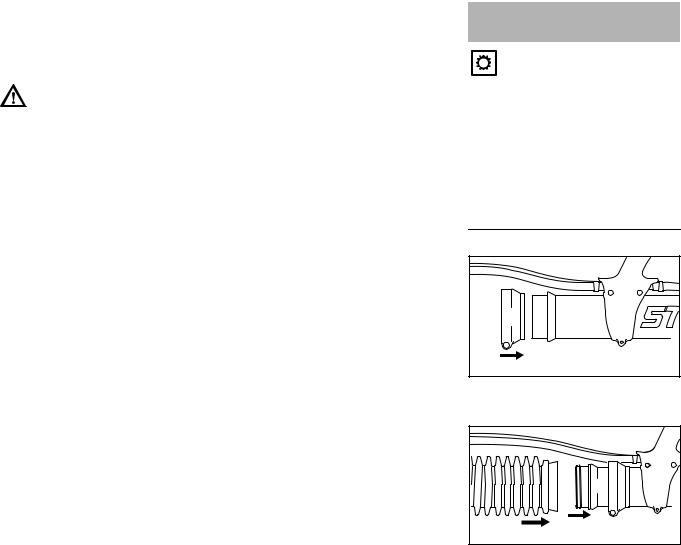
English
Strictly follow the maintenance and repair instructions in the appropriate section in this instruction manual.
Please refer to the maintenance chart in this instruction manual.
Warning!
Always stop the engine and make sure that the fan is stopped before doing any maintenance or repair work or cleaning the power tool. Do not attempt any maintenance or repair work not described in this instruction manual. Have such work performed by your STIHL servicing dealer only.
Do not clean your machine with a pressure washer. The solid jet of water may damage parts of the machine.
 Warning!
Warning!
Use the specified spark plug and make sure it and the ignition lead are always clean and in good condition. Always press spark plug boot snugly onto spark plug terminal of the proper size. (Note: If terminal has detachable SAE adapter nut, it must be securely attached.) A loose connection between spark plug terminal and the ignition wire connector in the boot may create arcing that could ignite combustible fumes and cause a fire.
 Warning!
Warning!
Never test the ignition system with the boot removed from the spark plug or with a removed spark plug, since uncontained sparking may cause a fire.
 Warning!
Warning!
Do not operate your power tool if the muffler is damaged, missing or modified. An improperly maintained muffler will increase the risk of fire and hearing loss. If your muffler was equipped with a spark-arresting screen to reduce the risk of fire, never operate your power tool if the screen is missing or damaged. Remember that the risk of forest fires is greater in hot or dry weather.
Tighten all nuts, bolts and screws except the carburetor adjustment screws after each use.
For maintenance items please also refer to the maintenance chart in this instruction manual.
Store the power tool in a dry and high or locked location out of reach of children.
Before storing for longer than a few days, always empty the fuel tank. See chapter "Storing the machine" in this instruction manual.
Store fuel in an approved and properly labeled safety-type canister only. Take care when handling gasoline! For health and safety reasons, avoid direct contact with the skin and avoid inhaling fuel vapor!
Assembling the Unit
Hose and throttle cable, and the  metering unit's operating cable on the SR 450, come connected
metering unit's operating cable on the SR 450, come connected
ready for use and must not be kinked while assembling the machine.
The combination wrench and screwdriver are in the supplied accessory bag.
Fitting the pleated hose on the blower tube
1 2
0002BA003 KN
NSlide the wide hose clamp (1) onto the blower tube (2) and line it up.
3 |
2 |
|
KN |
4 |
0002BA004 |
|
NPush the ring seal (3) (wide lip facing left) onto the blower tube (2).
NPush the pleated hose (4) over the ring seal (3).
12 |
SR 430, SR 450 |
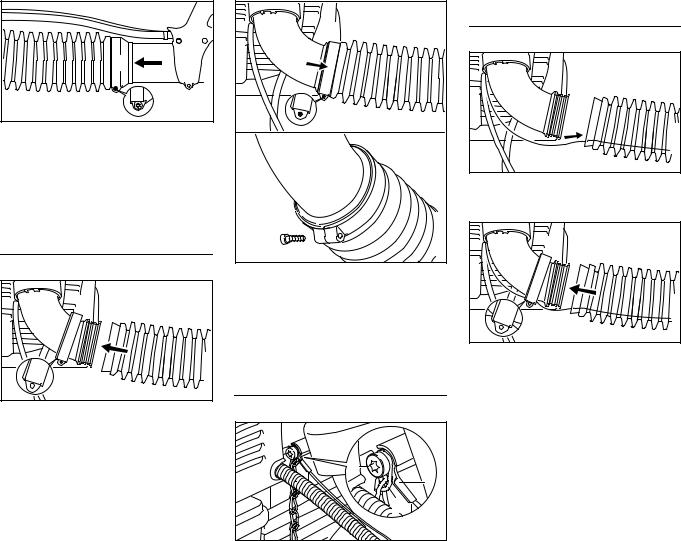
|
1 |
|
KN |
|
|
|
2 |
||
4 |
5 |
0002BA005 |
||
|
||||
|
|
|
NSlide the wide hose clamp (1) onto the pleated hose (4).
NSecure the wide hose clamp (1) with the screw (5) – the blower tube (2) must still rotate.
Fitting the pleated hose on the elbow
– SR 430 only
7 |
6 |
4 |
|
||
|
|
|
|
|
0002BA006 KN |
NSlide the narrow hose clamp (6) (bezel facing left) onto the elbow and line it up.
NPush the pleated hose (4) over the elbow (7).
6 |
4 |
8 |
|
|
KN |
8 |
0002BA007 |
6 |
NSlide the narrow hose clamp (6) onto the pleated hose (4).
NSecure the hose clamp (6) with the screw (8) from the side facing the operator.
Fitting the antistatic system – SR 450 only
3 |
1 |
|
|
||
2 |
KN |
|
0002BA054 |
||
|
NAttach the antistatic wire (1) and chain (2) to the blower housing with screw (3).
English
Fitting the pleated hose on the elbow
– SR 450 only
9 |
4 |
0002BA008 KN |
NPush the antistatic wire (9) into the pleated hose (4).
7 |
6 |
4 |
|
||
|
|
|
|
|
KN |
|
9 |
0002BA009 |
|
|
NSlide the narrow hose clamp (6) (bezel facing left) onto the elbow and line it up.
NPush the antistatic wire (9) between the ends of the narrow hose clamp (6).
NPush the pleated hose (4) over the elbow (7).
SR 430, SR 450 |
13 |
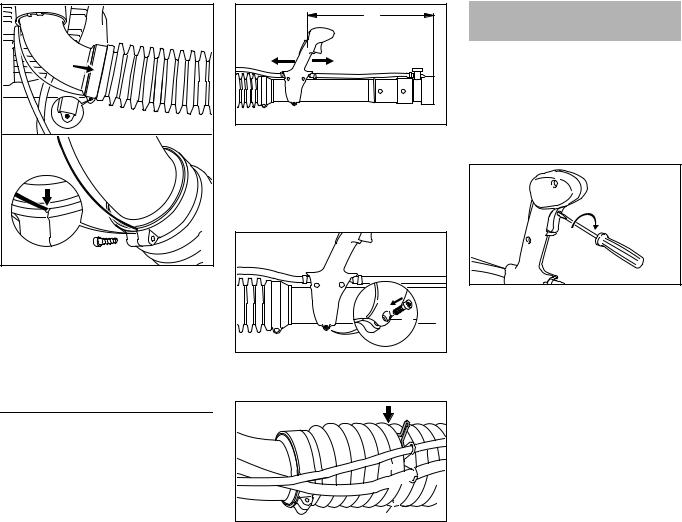
English |
|
6 |
4 |
8 |
|
|
KN |
8 |
0002BA010 |
6 |
NSlide the narrow hose clamp (6) onto the pleated hose (4).
NSecure the hose clamp (6) with the screw (8) from the side facing the operator – make sure the antistatic wire is positioned in the notch.
Adjusting and securing the control handle
NPut the machine on your back and adjust the harness – see "Harness".
|
a |
|
|
1 |
2 |
KN |
|
0002BA011 |
|||
|
|
NSlide the control handle (1) along the tube to the most comfortable position – distance between nozzle outlet (2) and the control handle (1) must be at least 19.7 in. (a)
(500 mm).
1 |
3 |
KN |
|
0002BA058 |
|
|
|
NSecure the control handle (1) with the screw (3).
4

 KN0002BA012
KN0002BA012
NUse the retainer (4) to secure the hose and throttle cable, and metering unit's operating cable on the SR 450, to the 6th pleat (arrow) on the pleated hose.
Adjusting the Throttle
Cable
It may be necessary to correct the adjustment of the throttle cable after assembling the machine or after a prolonged period of operation.
Adjust the throttle cable only when the unit is completely and properly assembled.
0002BA013 KN
NSet throttle trigger to the full throttle position – as far as stop.
NCarefully rotate the screw in the throttle trigger in the direction of the arrow until you feel initial resistance. Then rotate it another full turn.
14 |
SR 430, SR 450 |
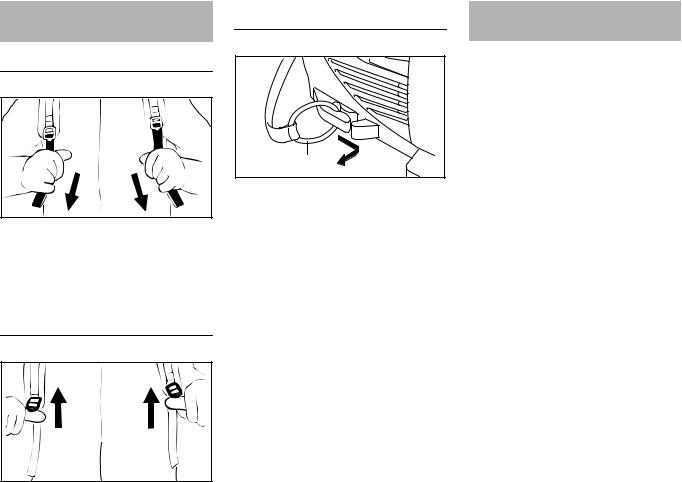
Harness |
Disconnecting harness from |
|
backplate |
Adjusting the harness |
|
|
|
KN |
KN |
1 |
0002BA055 |
373BA003 |
N Pull the ring (1) out of the slot. |
|
|
|
NPull the ends of the straps downward to tighten the harness.
NAdjust the harness so that the backplate fits snugly and securely against your back.
Loosening the harness
373BA004 KN
N Lift the tabs of the sliding adjusters.
English
Fuel
This engine is certified to operate on unleaded gasoline and the STIHL twostroke engine oil at a mix ratio of 50:1.
Your engine requires a mixture of highquality gasoline and quality two-stroke air cooled engine oil.
Use mid-grade unleaded gasoline with a minimum octane rating of 89 (R+M/2). If the octane rating of the mid-grade gasoline in your area is lower, use premium unleaded fuel.
Fuel with a lower octane rating may increase engine temperatures. This, in turn, increases the risk of piston seizure and damage to the engine.
The chemical composition of the fuel is also important. Some fuel additives not only detrimentally affect elastomers (carburetor diaphragms, oil seals, fuel lines, etc.), but magnesium castings and catalytic converters as well. This could cause running problems or even damage the engine. For this reason STIHL recommends that you use only nationally recognized high-quality unleaded gasoline!
Use only STIHL two-stroke engine oil or equivalent high-quality two-stroke engine oils that are designed for use only in air cooled two-cycle engines.
We recommend STIHL 50:1 two-stroke engine oil since it is specially formulated for use in STIHL engines.
Do not use BIA or TCW rated (twostroke water cooled) mix oils or other mix oils that state they are for use in both
SR 430, SR 450 |
15 |
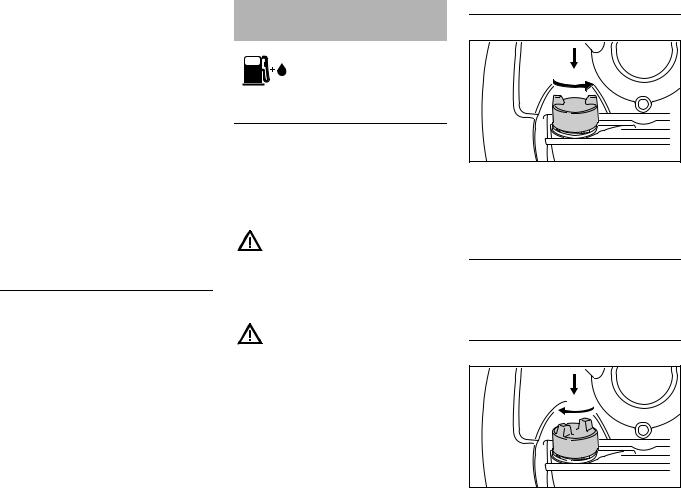
English
water cooled and air cooled engines (e.g., outboard motors, snowmobiles, chain saws, mopeds, etc.).
Take care when handling gasoline. Avoid direct contact with the skin and avoid inhaling fuel vapor. When filling at the pump, first remove the canister from your vehicle and place the canister on the ground before filling. Do not fill fuel canisters that are sitting in or on a vehicle.
The canister should be kept tightly closed in order to avoid any moisture getting into the mixture.
The machine‘s fuel tank and the canister in which fuel mix is stored should be cleaned as necessary.
Fuel mix ages
Only mix sufficient fuel for a few days work, not to exceed 3 months of storage. Store in approved fuel-canisters only. When mixing, pour oil into the canister first, and then add gasoline. Close the canister and shake it vigorously by hand to ensure proper mixing of the oil with the fuel.
Gaso- |
Oil (STIHL 50:1 or equiva- |
line |
lent high-quality oils) |
US gal. |
US fl.oz |
1 |
2.6 |
2 1/2 |
6.4 |
5 |
12.8 |
Dispose of empty mixing-oil canisters only at authorized disposal locations.
Fueling
Preparations
Before fueling, clean the fuel filler cap and the area around it so that dirt cannot fall into the tank.
Thoroughly shake up the mixture in the canister before fueling your machine.
To avoid the risk of burns or other injuries due to escaping gasoline vapors, open the fuel filler cap carefully so that any excess pressure in the tank can escape slowly.
Never use a tool to open the
bayonet catch. This could damage the cap and cause fuel to leak out.
Do not spill any fuel and do not fill the tank up to the brim.
Open the fuel filler cap
1.
 2.
2.
0002BA014 KN
NPress the cap down with your hand as far as possible, turn it counterclockwise (approx. 1/8 turn) and remove it.
Fueling
Take care not to spill fuel while fueling and do not overfill the tank.
Close the fuel filler cap
1.
2.
0002BA015 KN
NFit the cap and turn it until it engages in the bayonet mount.
NPress the cap down with your hand as far as possible and turn it clockwise (approx. 1/8 turn) until it engages completely.
16 |
SR 430, SR 450 |
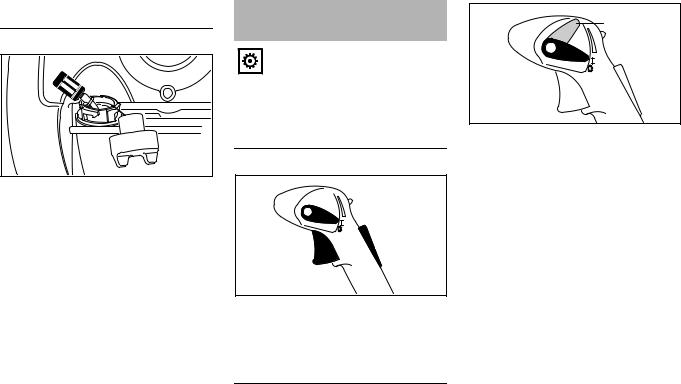
Change the fuel pickup body every year
0002BA016 KN |
N Drain the fuel tank.
NPull the fuel pickup body out of the tank with a hook and disconnect it from the hose.
NConnect a new fuel pickup body to the hose.
NReturn the fuel pickup body to the tank.
Information Before You
Start
With the engine stopped and before starting, check the air
intakes between the backplate and powerhead for blockages and clean if necessary.
Control handle
|
1 |
2 |
3 |
KN |
|
|
0002BA017 |
1Setting lever
2Throttle trigger
3Throttle trigger interlock
Functions of setting lever
Run position F
Engine runs or is ready to start. Throttle trigger (2) can be moved to any position.
Stop position 0
Ignition is interrupted, engine stops. The setting lever (1) is not locked in this position. It springs back to the run position. The ignition is switched on again.
Throttle trigger limiter position
Travel of throttle trigger can be limited in two stages:
English
a  b
b
0002BA053 KN
a1/3 throttle
b2/3 throttle
To disengage the travel limiter,
Nreturn the setting lever (1) to the run position F.
SR 430, SR 450 |
17 |
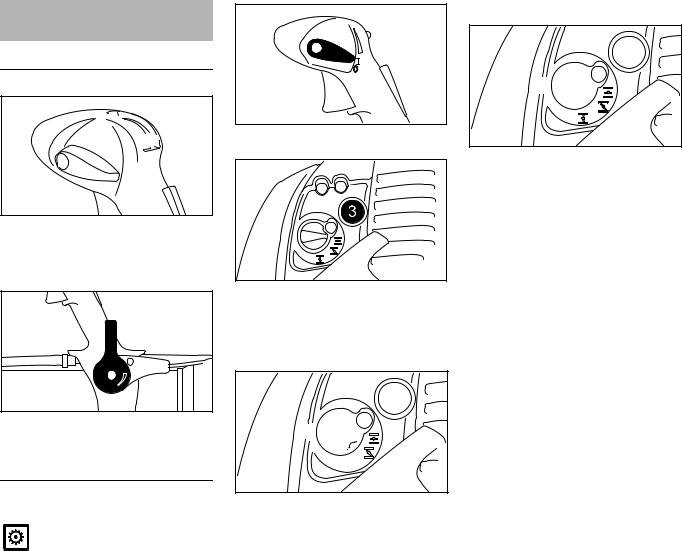
English
Starting / Stopping the
Engine
Before starting
 1
1
0002BA060 KN
NClose valve lever (1) for solution feed.
Additionally on SR 450:
2 |
0002BA052 KN |
NClose the metering lever (2) for dusting and spreading mode.
Starting the engine
N Observe safety precautions.
Start your unit on a clean, dustfree surface only to ensure that no dust is sucked in.
0002BA019 KN
N The setting lever must be on F
L
H
LA
0002BA020 KN
NPress the fuel pump bulb (3) at least eight times – even if the bulb is filled with fuel.
Cold engine (cold start)
4 
 KN0002BA021
KN0002BA021
NPress in the choke knob (4) and turn it to c.
Warm engine (warm start)
4  KN0002BA022
KN0002BA022
NPress in the choke knob (4) and turn it to o.
Also use this setting if the engine has been running but is still cold.
18 |
SR 430, SR 450 |

Cranking |
0002BA023 KN |
NPlace the unit securely on the ground and make sure that bystanders are well clear of the nozzle outlet.
NMake sure you have a firm footing: Hold the unit with your left hand on the housing and put one foot against the base plate to prevent it slipping.
NPull the starter grip slowly with your right hand until you feel it engage and then give it a brisk strong pull. Do not pull out the starter rope to full length – it might otherwise break.
NDo not let the starter grip snap back. Guide it slowly back into the housing so that the starter rope can rewind properly.
NContinue cranking until the engine runs.
As soon as the engine runs
4 
 KN0002BA024
KN0002BA024
NPull the throttle trigger – the choke knob (4) automatically returns to the run position (e).
At very low outside temperatures:
NOpen throttle slightly – warm up the engine for a short period.
English
Shut off the engine
0002BA025 KN
NMove the setting lever in the direction of 0 – the engine stops – the setting lever springs back to the on position.
Other hints on starting
Engine stalls in cold start position c or under acceleration
NMove the choke knob to oand continue cranking until the engine runs.
Engine does not start in warm start position o
NMove the choke knob to cand continue cranking until the engine runs.
If the engine does not start
N Check that all settings are correct.
NCheck that there is fuel in the tank and refuel if necessary.
NCheck that the spark plug boot is properly connected.
N Repeat the starting procedure.
SR 430, SR 450 |
19 |
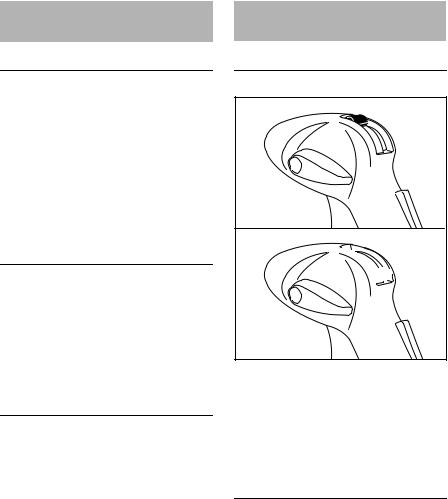
English
Fuel tank run until completely dry
NAfter refueling, press the fuel pump bulb at least eight times – even if the bulb is filled with fuel.
NSet the choke knob according to engine temperature.
N Start the engine.
Operating Instructions
During break-in period
A factory-new machine should not be run at high revs (full throttle off load) for the first three tank fillings. This avoids unnecessary high loads during the break-in period. As all moving parts have to bed in during the break-in period, the frictional resistances in the engine are greater during this period. The engine develops its maximum power after about 5 to 15 tank fillings.
During Operation
After a long period of full throttle operation, allow the engine to run for a short while at idle speed so that engine heat can be dissipated by the flow of cooling air. This protects enginemounted components (ignition, carburetor) from thermal overload.
After Finishing Work
Storing for a short period: Wait for the engine to cool down. Empty the fuel tank and keep the machine in a dry place, well away from sources of ignition, until you need it again. For longer out-of- service perionds – see "Storing the Machine".
Metering Unit
Valve lever
A |
1 |
B
 1
1
0002BA061 KN
Solution feed is started and stopped with the valve lever (1).
NPosition A (valve lever vertical, up)
– open
NPosition B (valve lever horizontal, down) – closed
Metering knobs
The scope of supply includes metering knobs which allow a wide range of different discharge rates.
20 |
SR 430, SR 450 |
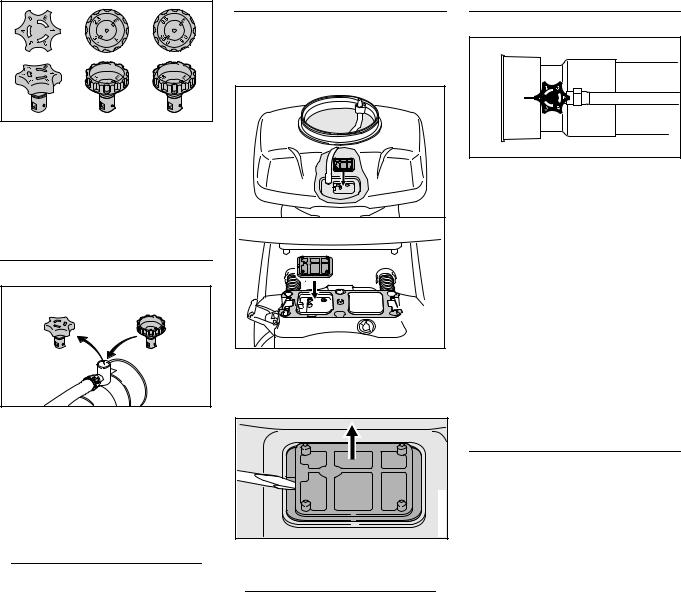
A |
B |
C |
0002BA064KN
–Standard metering knob (A) with positions 1 to 5
–Fine metering knob (B) with positions 1.0 to 2.3
–ULV metering knob 1) (C) with positions 0.5 to 0.8
Changing the metering knob
0002BA065 KN
NPull the existing metering knob up and out of its seat.
NPush the new metering knob into its seat as far as stop.
1)Included in the scope of supply or available as a special accessory - depending on market
SR 430, SR 450
Fitting the strainer 2)
The strainer supplied must always be fitted when the ULV metering knob is used.
SR 430
SR 450


 0002BA066 KN
0002BA066 KN
NPush the strainer into its seat until it snaps into position.
Removing |
0002BA067 KN |
NPry the strainer out of its seat – as shown.
2)Included with ULV metering knob
English
Adjusting the discharge rate
2 |
|
4 |
KN |
|
|
3 |
0002BA027 |
|
NTurn the metering knob (2) on the nozzle (3) to obtain the required discharge rate – see tables.
The numbers on the metering knob must be lined up with the lug (4) under the knob.
Position "E" is used for emptying the container. Do not use this position for spraying – see "After Finishing Work".
Machines with pressure pump (special accessory)
On machines with a pressure pump, use only the supplied "fine" metering knob with settings 1.0 to 2.3 or the ULV metering knob with settings 0.5 to 0.8.
Discharge rate without pressure pump
Spray tube 0° to -30° to the horizontal
21

English
"Standard" meterng knob
Knob position |
Discharge rate (l/min) |
|
(mean value) |
1 |
0,69 |
2 |
1,42 |
3 |
1,86 |
4 |
2,25 |
5 |
2,64 |
"Fine" meterng knob |
|
|
|
Knob position |
Discharge rate (l/min) |
|
(mean value) |
1.0 |
0,17 |
1.8 |
0,43 |
2.3 |
0,76 |
ULV metering knob |
|
|
|
Knob position |
Discharge rate (l/min) |
|
(mean value) |
0.5 |
0,05 |
0.65 |
0,09 |
0.8 |
0,14 |
Discharge rate with pressure pump (special accessory)
Spray tube horizontal (0°)
"Fine" meterng knob
Knob position |
Discharge rate (l/min) |
1.0 |
0,66 |
1.8 |
1,87 |
2.3 |
3,00 |
ULV metering knob
Knob position |
Discharge rate (l/min) |
0.5 |
0,19 |
0.65 |
0,33 |
0.8 |
0,48 |
Checking flow rate
N Place the unit on the ground.
NFill the container with water up to 10 liter mark.
Machines without pressure pump
NSet the "standard" metering knob to "5".
N Start the machine.
NHold the spray tube horizontally, run the engine at full throttle, spray the contents of the container down to the 5 liter mark and note the time taken.
The time required to spray 5 liters fluid should be betweeen 110 and 140 seconds.
Machines with pressure pump (special accessory)
N Set the "fine" metering knob to 2.3. N Start the machine.
NHold the spray tube horizontally, run the engine at full throttle, spray the contents of the container down to the 5 liter mark and note the time taken.
The time required to spray 5 liters fluid should be betweeen 90 and 120 seconds.
In case of deviations:
NCheck the container, hose system, metering knob and optional pressure pump for cantamination and clean if necessary.
NCheck blower air intake and clean if necessary.
NCheck engine setting and correct if necessary.
If there is no improvement, contact your dealer for assistance.
22 |
SR 430, SR 450 |
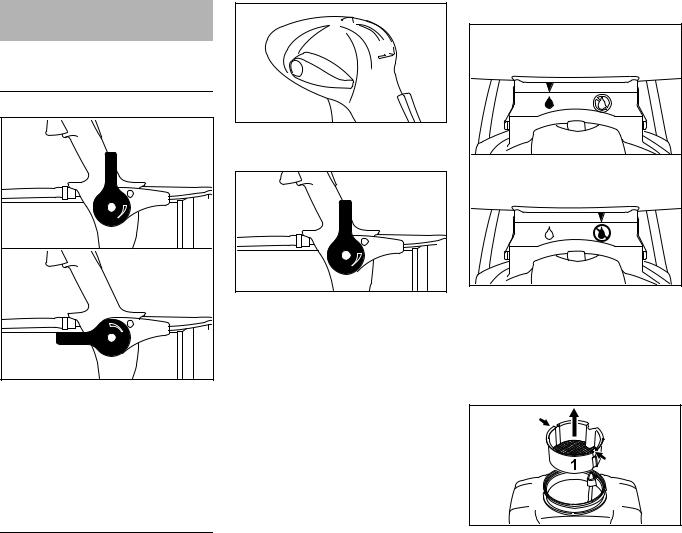
Dusting and Spreading
Mode
SR 450 only.
Metering lever
A |
|
|
1 |
B |
|
|
KN |
1 |
0002BA028 |
|
The discharge rate is infinitely variable with the metering lever (1).
NPosition A (metering lever vertical – feed closed
NPosition B (metering level parallel to blower tube) – feed open
Conversion from mistblowing to dusting and spreading mode
NEmpty and clean the solution container – see "After Finishing Work".
 1
1
0002BA060 KN
NClose valve lever (1) for solution feed.
2 |
0002BA052 KN |
NClose the metering lever (2) for dusting and spreading mode.
English
Solution container
A
B
0002BA029 KN
The selected operating mode is indicated by the symbols on the metering unit's housing.
N Position A – Mistblowing mode
NPosition B – Dusting and spreading mode
0002BA062 KN
NInsert a suitable tool (e.g. screwdriver) in the two recesses (arrows) to loosen the strainer (1).
NPull the strainer (1) upward and out of the solution container.
SR 430, SR 450 |
23 |
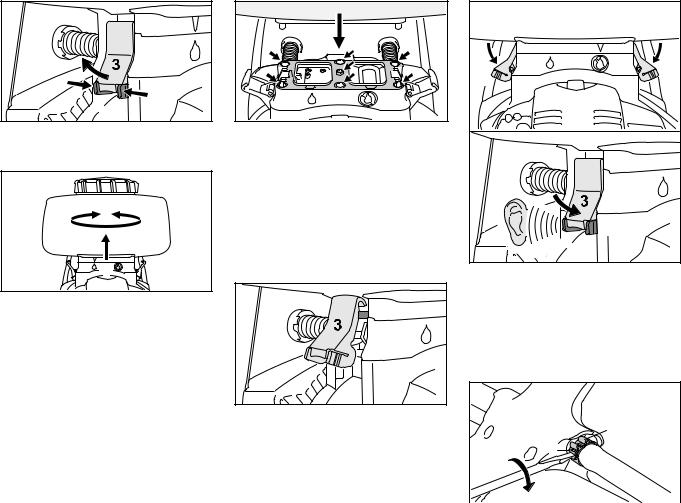
English |
|
|
2 |
2 |
0002BA031 KN |
NSqueeze the tabs (2) together and pull the lever (3) outwards.
|
KN |
4 |
0002BA032 |
|
NRemove the solution container from the metering unit's housing (4) and turn it to position B (dusting and spreading mode).
|
KN |
4 |
0002BA033 |
|
NThoroughly clean the plastic pins and the sealing face on the solution container – check that there is no residue.
NThoroughly clean the holes and sealing face on the metering unit (4)
– check that there is no residue.
NFit the solution tank on the metering unit's housing (4).
5 |
0002BA034 KN |
NHook the lever (3) over the bar (5) on the solution container.
3 |
6 |
|
|
6 |
3 |
|
|
|
|
||
|
|
|
6 |
|
KN |
|
2 |
2 |
|
0002BA035 |
|
|
|
|
|||
|
|
|
|
|
NPress the levers (3) down until the tabs (2) snap into their seats (6) on the housing with a loud click.
NCheck that the container is firmly seated.
Blower tube
2
1 |
KN |
|
3 |
||
0002BA036 |
||
|
NInsert a screwdriver into the tab (1) of the hose clamp (2) on the control handle.
NTurn the screwdriver clockwise to loosen the hose clamp (2).
N Pull the hose (3) off the stub.
24 |
SR 430, SR 450 |
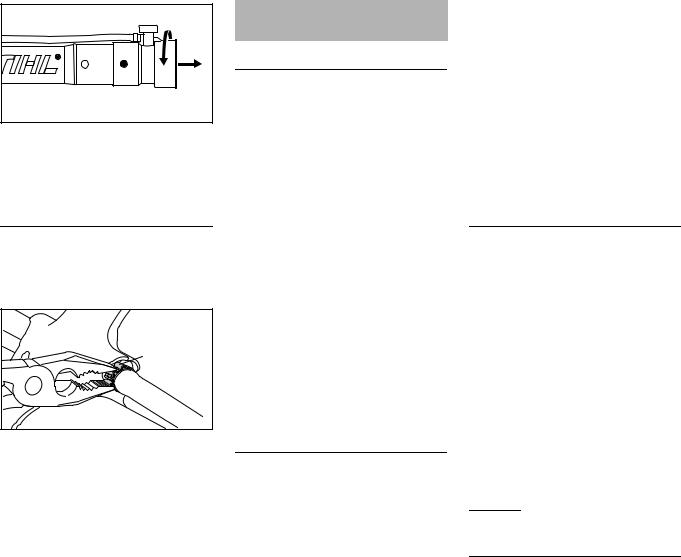
6 5 4 |
KN |
|
0002BA037 |
NRotate the nozzle (4) until the lugs (5) are covered.
NPull the nozzle (4) off the blower tube (6).
Converting back to misblowing mode
The conversion is carried out in the reverse sequence.
Fitting the hose
2 |
0002BA038 KN |
NPush the hose with clamp (2) over the stub on the control handle.
NUse pliers to squeeze the hose clamp together (2) until the retaining strip engages and locks.
Calculating Required
Quantity of Solution
Determining surface area (m2)
In the case of ground crops, simply multiply the length of the field by its width.
The surface area of high-growing plants is calculated approximately by measuring the length of the rows and the average height of the foliage. The result is multiplied by the number of rows and then by two if both sides have to be treated.
The surface area in hectares is obtained by dividing the number of square meters by 10,000.
Example:
A field 120 meters long and 30 meters wide has to be treated with a pesticide.
Area:
120 m x 30 m = 3,600 m2
3,600 / 10,000 = 0.36 ha
Determining quantity of active ingredient
Refer to the instructions supplied with the active ingredient to determine:
–Required quantity of active ingredient for 1 hectare (ha).
–Concentration of active ingredient (mix ratio).
English
Multiply the required quantity of active ingredient for 1 hectare by the area determined in hectares. The result is the quantity of active ingredient required for the area to be treated.
Example:
According to the maker’s instructions, 0.4 liters of active ingredient are required per hectare to obtain a concentration of 0.1%.
Quantity of active ingredient:
0.4 (l/ha) x 0.36 (ha) = 0.144 l
Determining quantity of solution
The quantity of solution required is calculated as follows:
TW |
x 100 = TB |
|
K |
||
|
TW = Quantity of active ingredient in l K = Concentration in %
TW = Required quantity of solution in l
Example:
The calculated quantity of active ingredient is 0.144 liters. According to the maker’s instructions, the concentration is 0.1%.
Quantity of solution:
0.144 l |
x 100 = 144 l |
0,1 % |
Determining walking speed
Carry out a trial run with the machine fueled and the container filled with water. Operate the spray tube (swing it
SR 430, SR 450 |
25 |
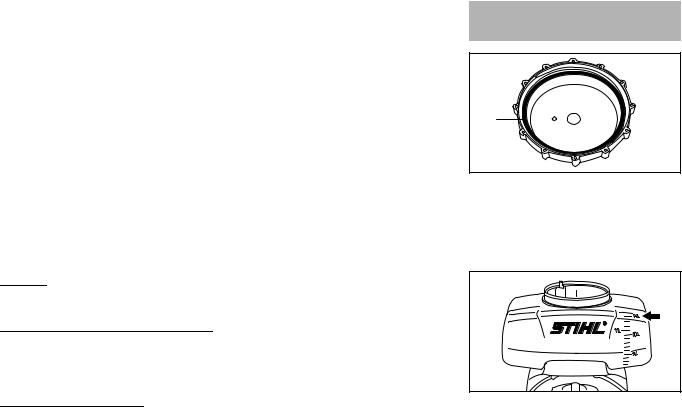
English
back and forth) as for the real run described below. Determine the distance walked in one minute.
Also use the trial run to check the selected working width. The best working width for low-growing crops is 4–5 m. Mark the working width with stakes.
Dividing the distance walked in meters by the time in minutes gives you the walking speed in meters per minute (m/min).
Example:
The distance covered in one minute is 10 meters.
Walking speed:
10 m
= 10 m/min
1 min
Determining discharge rate
The setting of the metering unit is calculated as follows:
Va(l) x vb(m/min) x b(m) |
= Vc(l/min) |
2 |
|
A (m ) |
|
Va = Quantity of solution |
|
vb = Walking speed |
|
Va = Discharge rate |
|
b = Working width |
|
A = Area |
|
Example: |
|
The values determined above and a working width of 4 meters require the following setting on the metering unit:
144 l x 10 (m/min) x 4 m |
= 1.6 l/min |
|
3,600 m2 |
||
|
Hectares (ha) have to be converted into m2 (ha x 10,000 = m2).
To adjust the required discharge rate see "Metering Unit".
Filling the Container
1
372BA021 KN
NThe gasket (1) in the cap must be in good condition, lubricated with grease and clean.
NStand the machine on a level surface.
0002BA039 KN
NDo not exceed maximum level of 3.7 gal (14 liters) (arrow).
26 |
SR 430, SR 450 |
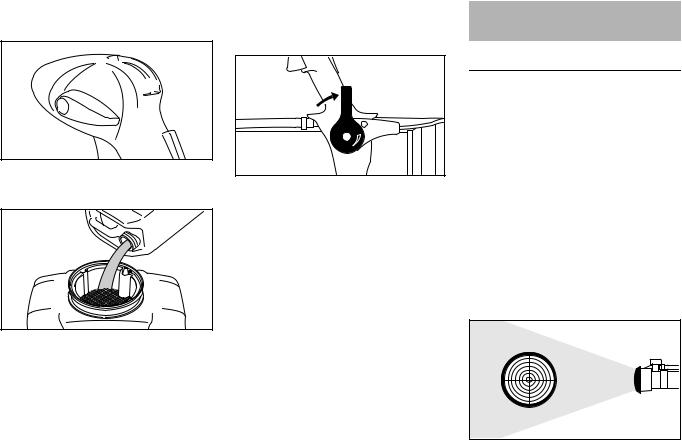
English
Mistblowing |
|
Dusting and spreading mode – |
|
|
SR 450 only |
Working
 1
1
0002BA060 KN
NClose valve lever (1) for solution feed.
0002BA041 KN
NPour thoroughly mixed spray solution into the container through the strainer.
NFit the cap and tighten it down firmly.
1 |
0002BA042 KN |
N Close the metering lever (1).
N Pour the material into the container.
NFit the cap and tighten it down firmly.
Mistblowing
The metering lever on the SR 450 must be closed when operating in the mistblowing mode – see dusting and spreading mode.
NAdjust discharge rate with the metering knob – see "Metering Unit".
NOpen the valve lever – see "Metering Unit".
Different baffle screens can be fitted to alter the shape and direction of the spray for accurate application of the solution.
Conical screen
372BA006 KN |
Spray is finely atomized – short, broad and dense spray mist.
SR 430, SR 450 |
27 |
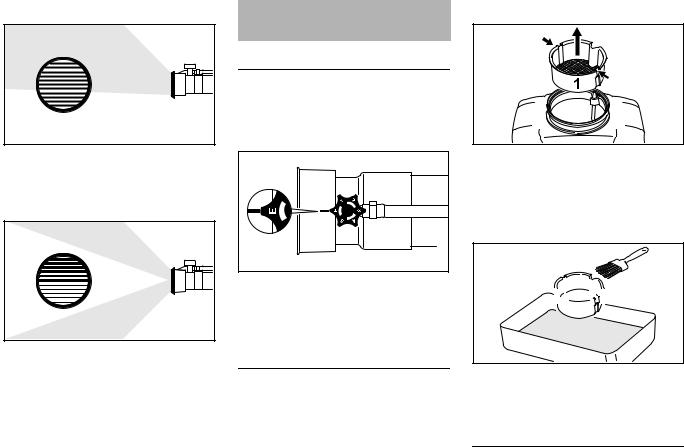
English
Deflector screen
372BA007 KN |
Diverts spray upwards – for under-leaf treatment of low-growing crops.
Dual defelector screen
372BA008 KN |
Splits the spray in two – allows two closely planted rows to be treated in one pass.
After Finishing Work
Emptying the solution container
N Close the valve lever.
NShut off the engine – see "Starting / Stopping the Engine".
1 |
0002BA044 KN |
NTurn the metering knob (1) to position "E" and collect the remaining solution in a suitable container.
Cleaning the solution container
NRinse and clean the solution container and hose system with clear water.
NDispose of remaining spray solution and rinsing liquid in accordance with local environmental requirements – follow maker's instructions.
NAllow the machine to dry with the cap removed.
If strainer is dirty:
0002BA062 KN
NInsert a suitable tool (e.g. screwdriver) in the two recesses (arrows) to loosen the strainer (1).
NPull the strainer (1) upward and out of the solution container.
 2
2
0002BA045 KN
NClean the strainer (2) with clear water and a brush.
After dusting and spreading – SR 450 only
NRun the unit until the solution container is completely empty
N Close the metering lever.
NShut off the engine – see "Starting / Stopping the Engine".
NRinse and clean the solution container with clear water.
28 |
SR 430, SR 450 |
